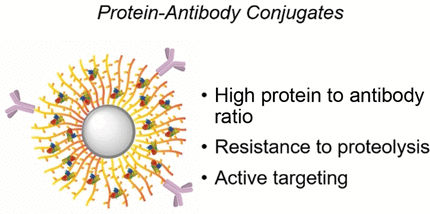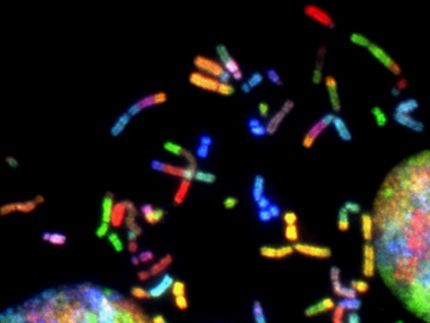Protected by Nanobrushes
Inserting active-agent proteins into cancer cells using antibodies
Advertisement
The ability of antibodies to recognize specific cancer cells is used in oncology to specifically target those cells with small active agents. Research published in the journal Angewandte Chemie shows that scientists have now built a transport system that delivers even large protein-based drugs into cancer cells. This study demonstrates how proteins can arrive at their target intact, protected from destructive proteases by polymer brushes.

© Wiley-VCH
Developing anticancer treatments involves two recurring problems for researchers. An active agent needs to be able to kill the body’s cells at the root of the cancer, and it should be active in target cancer cells rather than in healthy cells. Many medical researchers are therefore working on the concept of a cargo package. The active agent stays protected and packaged until it reaches the target location, while antibodies that only attach to cancer cells help with “finding the right address”.
These antibodies recognize specific receptor structures on the outer membrane of cancer cells. They attach to these structures and the cell absorbs the active agent. However, this strategy is unsuccessful when the active agents are large proteins. Proteins of this type are usually water soluble and they cannot pass through the cell membrane. A further issue is caused by the body’s own protease enzymes, which break down the transported proteins before they can reach their target location.
Sankaran Thayumanavan and colleagues at the University of Massachusetts in Amherst, USA, have now developed a particular protected nanosized cargo package, which meets both requirements of targeted delivery and keeping the cargo intact. They use miniscule beads made of silicon dioxide with a diameter of just 200 nanometers. The surface of these beads is covered with brush-like polymer strands made of polyethylene glycol (PEG) that can be doubly functionalized, giving tiny “brush beads”.
The researchers attached the desired active-agent protein and antibodies to the polymer bristles using simple click chemistry. The finished bead-shaped packages have antibodies on the very outside, with the proteins tucked away safely within the forest of polymer strands.
As well as being able to transport water-soluble proteins, this type of protein–antibody conjugate (PAC) also afforded the researchers another potential advantage: the possibility of attaining a high protein–antibody ratio in this format. They say that, at least in theory, more than 10 000 proteins could be transported per (expensive) antibody using the researchers’ PACs, unlike the maximum of four active agents per antibody in previous antibody–drug combinations.
The team tested their system on various cell cultures with different antibodies and test proteins. As planned, the proteins reached their targets in the cell and fulfilled their deadly role.
The team’s next steps involve working out whether the cargo packages can be protected from the body’s macrophages. However, they are optimistic because the PEG functionalities and the surface antibodies are designed for a quick delivery while minimizing clearance by macrophages.
Original publication
Other news from the department science
Most read news
More news from our other portals
See the theme worlds for related content
Topic world Antibodies
Antibodies are specialized molecules of our immune system that can specifically recognize and neutralize pathogens or foreign substances. Antibody research in biotech and pharma has recognized this natural defense potential and is working intensively to make it therapeutically useful. From monoclonal antibodies used against cancer or autoimmune diseases to antibody-drug conjugates that specifically transport drugs to disease cells - the possibilities are enormous

Topic world Antibodies
Antibodies are specialized molecules of our immune system that can specifically recognize and neutralize pathogens or foreign substances. Antibody research in biotech and pharma has recognized this natural defense potential and is working intensively to make it therapeutically useful. From monoclonal antibodies used against cancer or autoimmune diseases to antibody-drug conjugates that specifically transport drugs to disease cells - the possibilities are enormous




























































